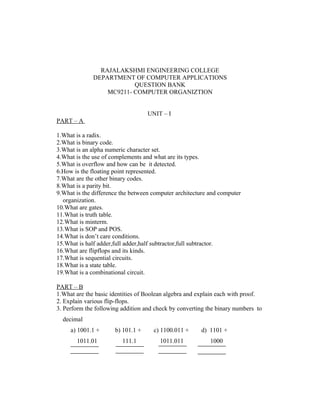Mca co qb
- 1. RAJALAKSHMI ENGINEERING COLLEGE DEPARTMENT OF COMPUTER APPLICATIONS QUESTION BANK MC9211- COMPUTER ORGANIZTION UNIT â I PART â A 1.What is a radix. 2.What is binary code. 3.What is an alpha numeric character set. 4.What is the use of complements and what are its types. 5.What is overflow and how can be it detected. 6.How is the floating point represented. 7.What are the other binary codes. 8.What is a parity bit. 9.What is the difference the between computer architecture and computer organization. 10.What are gates. 11.What is truth table. 12.What is minterm. 13.What is SOP and POS. 14.What is donât care conditions. 15.What is half adder,full adder,half subtractor,full subtractor. 16.What are flipflops and its kinds. 17.What is sequential circuits. 18.What is a state table. 19.What is a combinational circuit. PART â B 1.What are the basic identities of Boolean algebra and explain each with proof. 2. Explain various flip-flops. 3. Perform the following addition and check by converting the binary numbers to decimal a) 1001.1 + b) 101.1 + c) 1100.011 + d) 1101 + 1011.01 111.1 1011.011 1000
- 2. 4.Perform the following subtraction of binary numbers , using both 1âs & 2âs complements a) 11011 - b) 11011 - 10011.11 11001 5. sExplain with example SOP and POS. 6. Converting the following a) (15)8 to decimal b) (7423)8 to binary c) (A492)16 to decimal d) (101101110)2 to decimal 7. a) State and prove DeMorganâs theorem b) Prepare a table of combination and prove (X + Y) (X + Z) = X + YZ 7. Draw the truth table Karnaugh map and simplify the following expressions in four Variables W, X, Y, and Z : m0+m5+m7+m8+m11+m13+m15 9. Design an AND-to-OR gate combinational network for the Boolean algebra function F = W' X' Y' Z' + W X' Y' Z + W X' Y' Z' + W X' Y Z + W' X Y' Z' Use as few gates as possible
- 3. UNIT II PART â A 1. What is integrated circuits. 2. What is a decoder, encoder, multiplexer, demultiplexer. 3. What is register, shift register, binary counter 4. What is memory unit. 5. What are the types of ROM. 6. What is micro-operation 7. What is a three-state gate. PART- B 1. Explain registers with parallel load. 2. Explain bidirectional shift register with parallel load. 3 .Explain binary counter with parallel load. 4. Explain arithmetic logic shift unit. UNIT â III PART â A 1. What is an instruction code. 2. What is an effective address. 3. What are the basic computer instruction formats. 4. Difference between hardwired control and microprogrammed control. 5. What is an interrupt cycle. 6. What is an assembly language and machine language. 7.What is an assembler. PART â B. 1.Explain common bus system in detail. 2.Explain the control unit of basic computer. 3.Explain about memory reference instructions 4.Explain complete computer description. 5.Explain design of basic computer. 6.Explain design of accumulator logic 7.Explain first pass and second pass assembler.
- 4. UNIT â IV PART - A 1.What is a peripheral. 2.What is a I/O command, control command, status, output data and input data. 3.What is isolated versus memory-mapped I/O. 4.What is synchronous and asynchronous data transfer. 5.What is polling. PART â B 1.Explain asynchronous data transfer. 2.Explain the modes of transfer. 3.Explain Daisy-Chaining priority. 4.Explain DMA. 5.Explain Input-Output Processor. UNIT â V PART â A 1.What is auxillary memory, cache memory. 2.What is locality of reference. 3.What is hit ratio. 4.What is a page frame. PART-B 1.Explain Associative memory. 2.Explain Cache memory. 3.Explain Virtual memory. 4.Explain in detail memory management hardware. 5.Explain general register organization. 6.Explain instruction formats. 7.Explain addressing modes.



